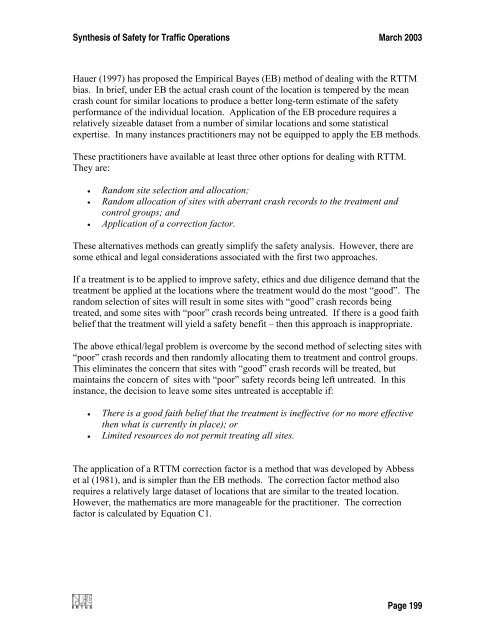Synthesis of Safety for Traffic Operations - Transports Canada
Synthesis of Safety for Traffic Operations - Transports Canada
Synthesis of Safety for Traffic Operations - Transports Canada
You also want an ePaper? Increase the reach of your titles
YUMPU automatically turns print PDFs into web optimized ePapers that Google loves.
<strong>Synthesis</strong> <strong>of</strong> <strong>Safety</strong> <strong>for</strong> <strong>Traffic</strong> <strong>Operations</strong> March 2003<br />
Hauer (1997) has proposed the Empirical Bayes (EB) method <strong>of</strong> dealing with the RTTM<br />
bias. In brief, under EB the actual crash count <strong>of</strong> the location is tempered by the mean<br />
crash count <strong>for</strong> similar locations to produce a better long-term estimate <strong>of</strong> the safety<br />
per<strong>for</strong>mance <strong>of</strong> the individual location. Application <strong>of</strong> the EB procedure requires a<br />
relatively sizeable dataset from a number <strong>of</strong> similar locations and some statistical<br />
expertise. In many instances practitioners may not be equipped to apply the EB methods.<br />
These practitioners have available at least three other options <strong>for</strong> dealing with RTTM.<br />
They are:<br />
• Random site selection and allocation;<br />
• Random allocation <strong>of</strong> sites with aberrant crash records to the treatment and<br />
control groups; and<br />
• Application <strong>of</strong> a correction factor.<br />
These alternatives methods can greatly simplify the safety analysis. However, there are<br />
some ethical and legal considerations associated with the first two approaches.<br />
If a treatment is to be applied to improve safety, ethics and due diligence demand that the<br />
treatment be applied at the locations where the treatment would do the most “good”. The<br />
random selection <strong>of</strong> sites will result in some sites with “good” crash records being<br />
treated, and some sites with “poor” crash records being untreated. If there is a good faith<br />
belief that the treatment will yield a safety benefit – then this approach is inappropriate.<br />
The above ethical/legal problem is overcome by the second method <strong>of</strong> selecting sites with<br />
“poor” crash records and then randomly allocating them to treatment and control groups.<br />
This eliminates the concern that sites with “good” crash records will be treated, but<br />
maintains the concern <strong>of</strong> sites with “poor” safety records being left untreated. In this<br />
instance, the decision to leave some sites untreated is acceptable if:<br />
• There is a good faith belief that the treatment is ineffective (or no more effective<br />
then what is currently in place); or<br />
• Limited resources do not permit treating all sites.<br />
The application <strong>of</strong> a RTTM correction factor is a method that was developed by Abbess<br />
et al (1981), and is simpler than the EB methods. The correction factor method also<br />
requires a relatively large dataset <strong>of</strong> locations that are similar to the treated location.<br />
However, the mathematics are more manageable <strong>for</strong> the practitioner. The correction<br />
factor is calculated by Equation C1.<br />
Page 199
















